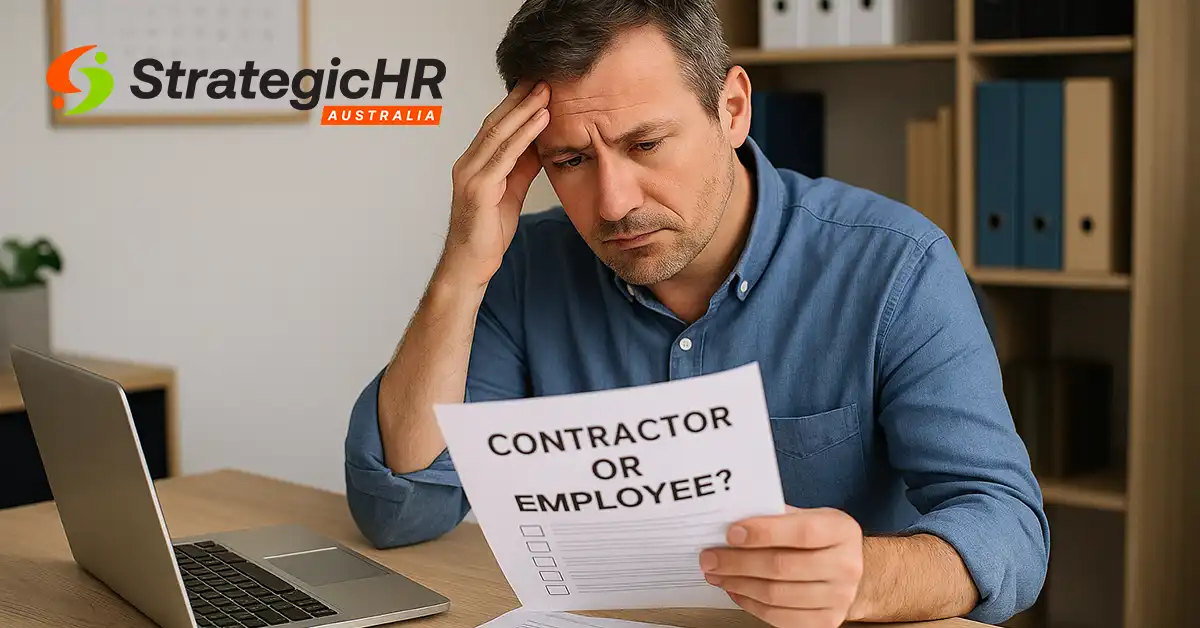In Western Australia, many small businesses rely on independent contractors to manage costs, boost flexibility, and meet demand during peak periods. However, the line between a true contractor and an employee isn’t always clear-cut—and getting it wrong can land your business in hot water.
Incorrectly classifying workers can result in sham contracting—a serious breach of employment law—and put your business at risk of non-compliance with the Fair Work Act, ATO obligations, and superannuation laws.
Sham Contracting is a Compliance Red Flag
What’s the difference between a contractor (independent contractor) and an employee?
The main difference between an independent contractor and an employee lies in the working relationship and the level of control the business has:
Employees work under a contract of service. The employer controls their hours, how the work is performed, and provides entitlements such as leave, superannuation, and protections under the Fair Work Act.
Contractors work under a contract for services. They generally decide how and when the work is completed, supply their own tools or equipment, and manage their own tax and super obligations.
Getting this distinction wrong can expose businesses to claims of sham contracting, where someone is incorrectly engaged as a contractor but is, in reality, an employee.
Try our Free HR Compliance Audit: Uncover hidden risks, check your legal obligations, and get a personalised compliance report in minutes.
What Is Sham Contracting?
- Superannuation
- Leave entitlements
- Workers’ compensation
- Payroll tax
- Misrepresent an employment relationship as a contracting arrangement
- Dismiss (or threaten to dismiss) an employee to re-engage them as a contractor
- Make false statements to persuade someone to work as a contractor
Signs It May Not Be a Genuine Independent Contracting Arrangement
- They are paid by the hour, not per job or outcome
- The business sets their hours, tasks, or procedures
- The worker uses the business’s tools or equipment
- They cannot delegate their work to someone else
- They are integrated into the business’s team
- They rely on the business for ongoing income
Not sure if your worker is truly an independent contractor?
Download our free Contractor vs Employee Checklist — a practical tool designed to help you make informed, compliant decisions with confidence.
Superannuation and Independent Contractors: What You Need to Know
- More than 50% of the payment is for labour
- The worker is paid for personal services, not a business outcome
The work can’t be delegated to another person
- SG Charge liabilities
- Penalties and interest charges
- Legal action from the ATO or Fair Work Ombudsman
- Reputational damage
How Strategic HR Australia Can Help You Stay Compliant
- Review current contractor arrangements
- Complete a practical Contractor vs Employee Checklist
- Draft the correct contract documents
- Ensure compliance with ATO, Fair Work, and state-based obligations
Train managers on how to lawfully engage independent contractors
Sham Contracting FAQs
What is sham contracting in Australia?
Sham contracting occurs when a business treats someone as an independent contractor even though, in reality, they should be considered an employee. This often happens when businesses try to avoid paying employee entitlements such as leave, superannuation, and minimum wage.
Is sham contracting illegal?
Yes. Under the Fair Work Act, sham contracting is unlawful. Businesses can face significant penalties if they misrepresent an employment relationship as an independent contracting arrangement. Both the business and individuals involved in the decision can be held liable.
What are the penalties for sham contracting?
Employers found guilty of sham contracting can face heavy financial penalties, back payments of entitlements, and reputational damage. The Fair Work Ombudsman and courts can order significant fines for both the business and individuals involved in the decision.
How to avoid sham contracting?
Avoid sham contracting by engaging genuine independent contractors under a clear contract for services, allowing control over how and when work is done, and not providing employee entitlements (e.g., leave, super). Document the arrangement, review it regularly, and get advice. If you’re unsure, work with a professional HR consultant like Strategic HR to assess your arrangements and train managers.
How can employers check if they are at risk of sham contracting?
You need to consider factors such as the level of control you have over the worker, whether they supply their own tools, if they can subcontract the work, and how they are paid. If you treat them like an employee, they are likely to be legally considered one — regardless of what the contract says.
One way to assess whether your arrangements might be at risk of sham contracting is to use a compliance checklist. Download our free Contractor vs Employee Checklist to help you identify the correct classification.
What is the 80/20 rule for contractors?
The 80/20 rule is an Australian tax rule under the ATO’s Personal Services Income (PSI) regime. Please note the 80/20 rule is not used to decide whether someone is an employee or an independent contractor — that’s determined separately under Fair Work’s whole-of-relationship test.
For more details, please see the ATO’s Myths and facts page for determining if a worker is an employee or independent contractor.







